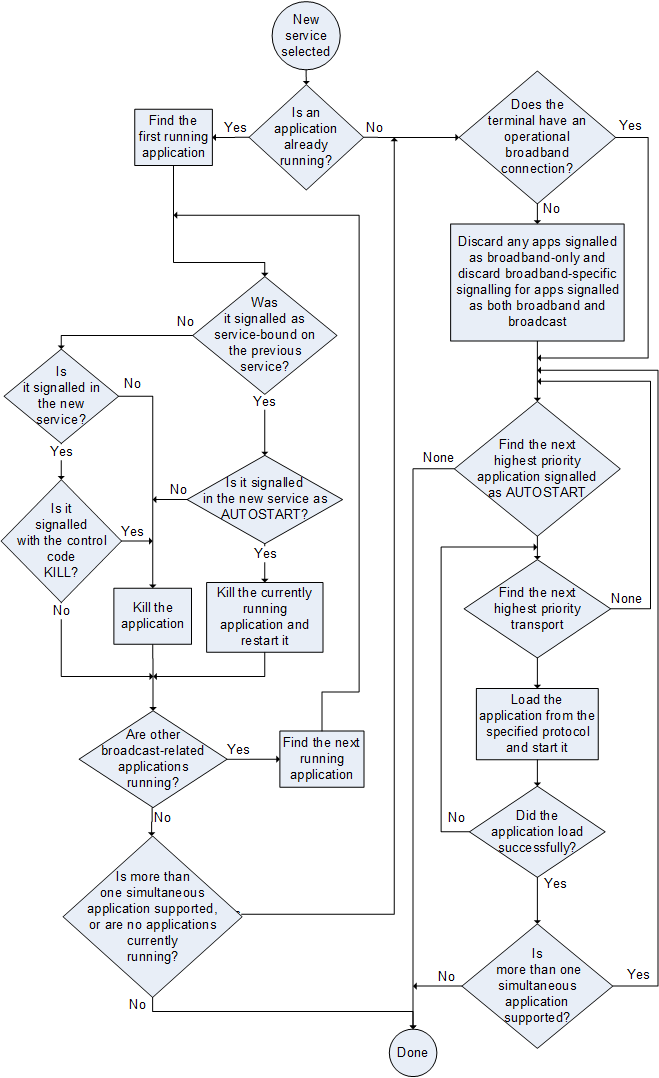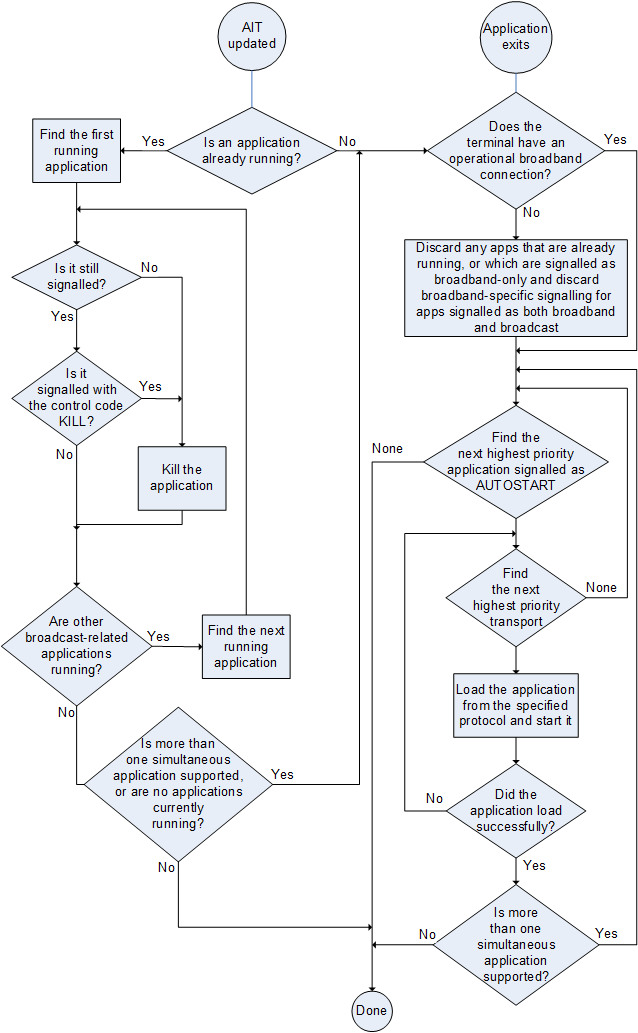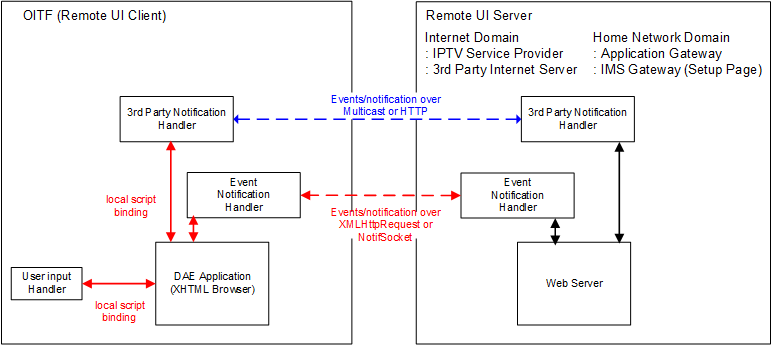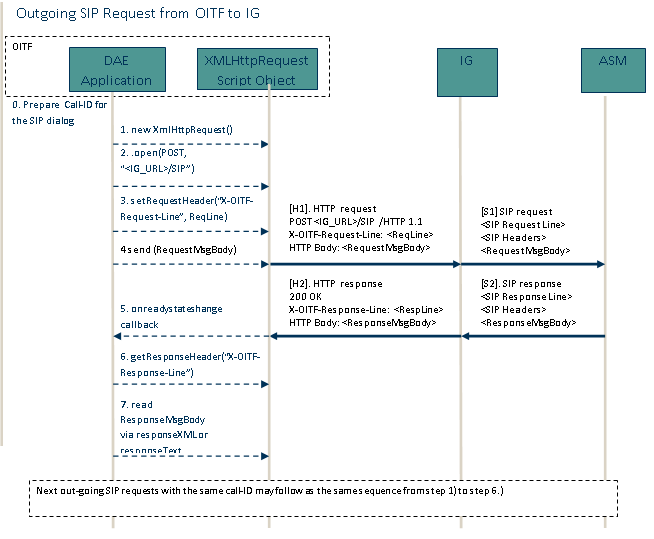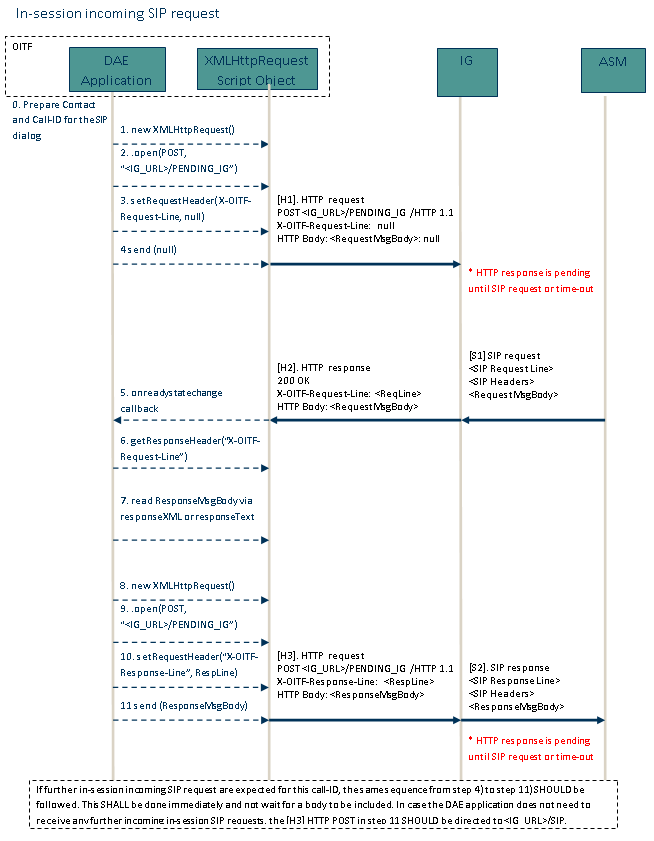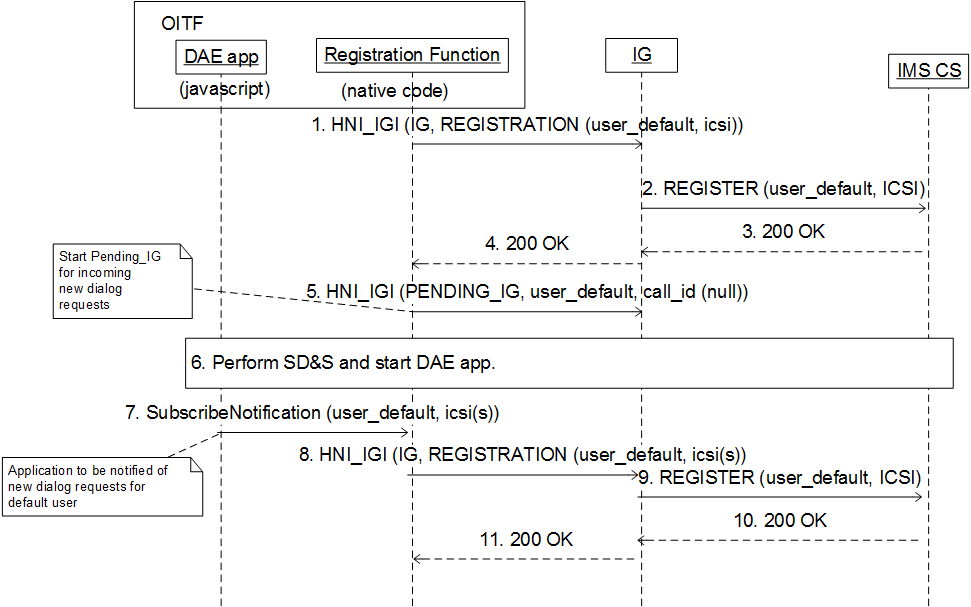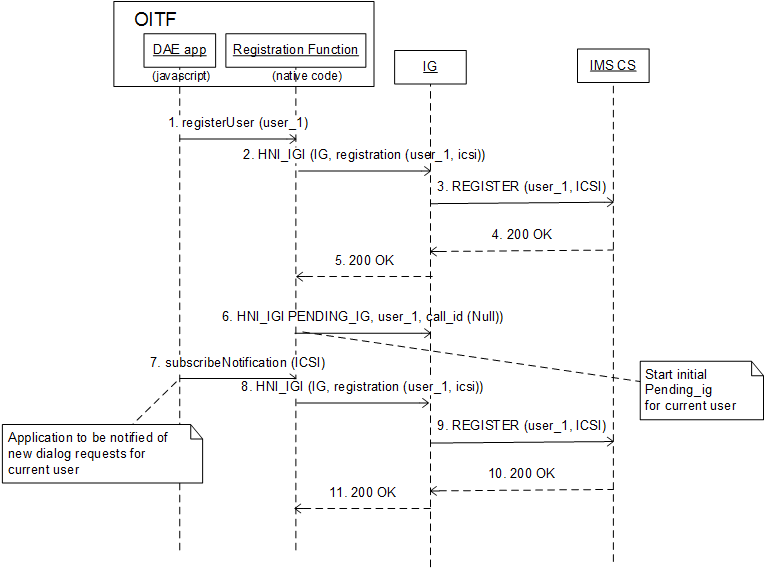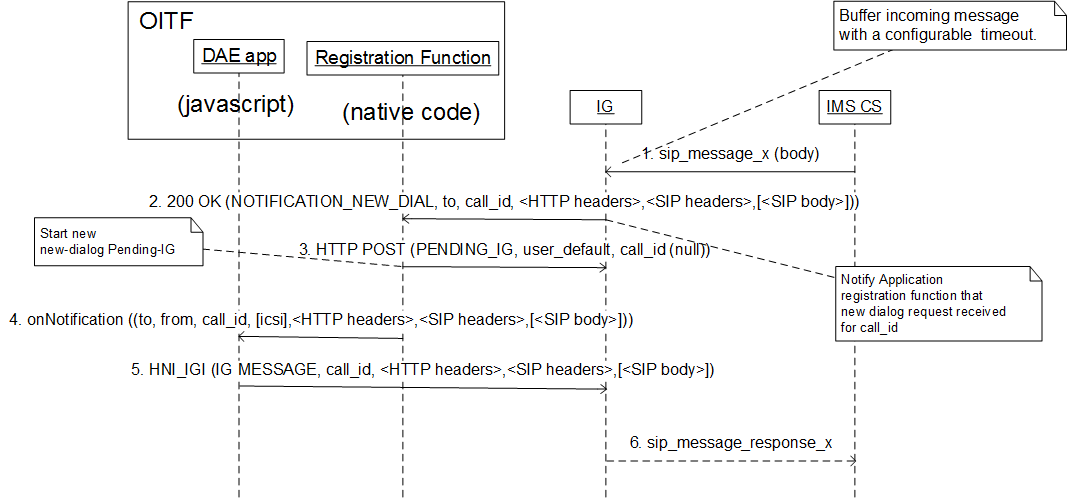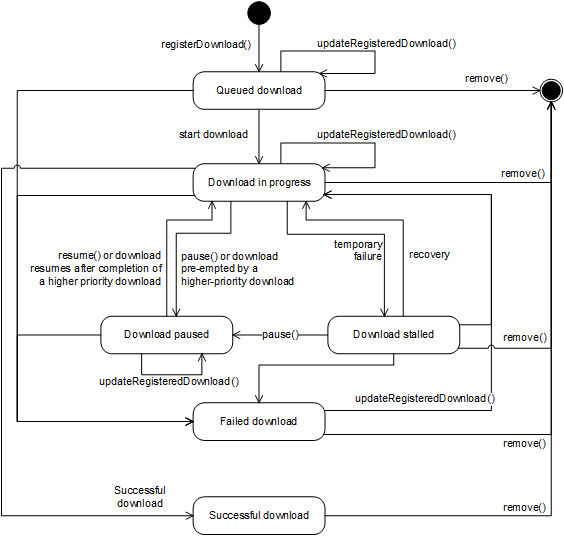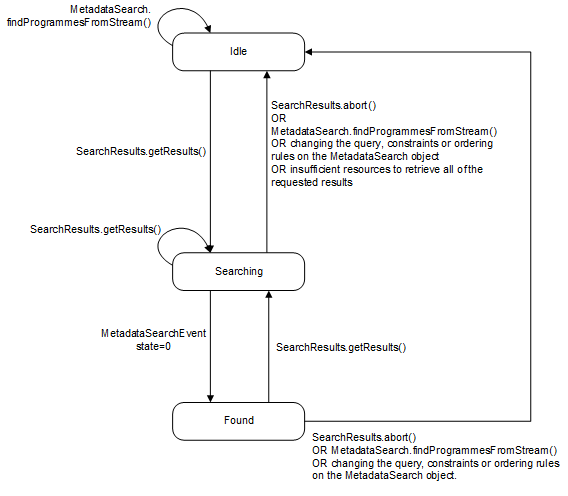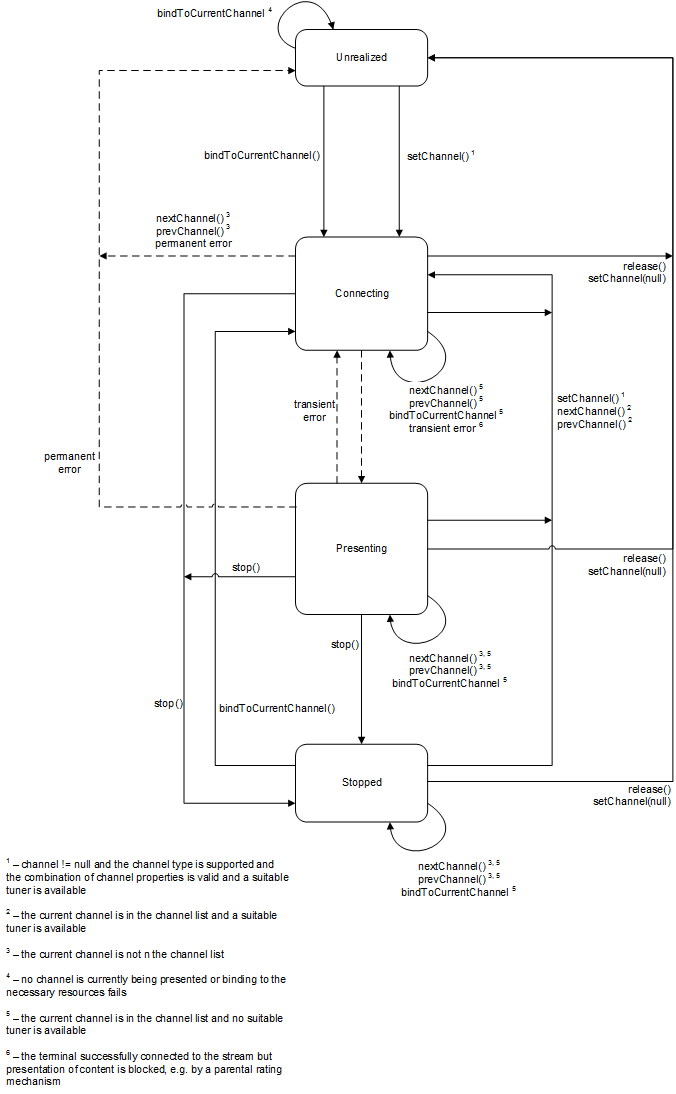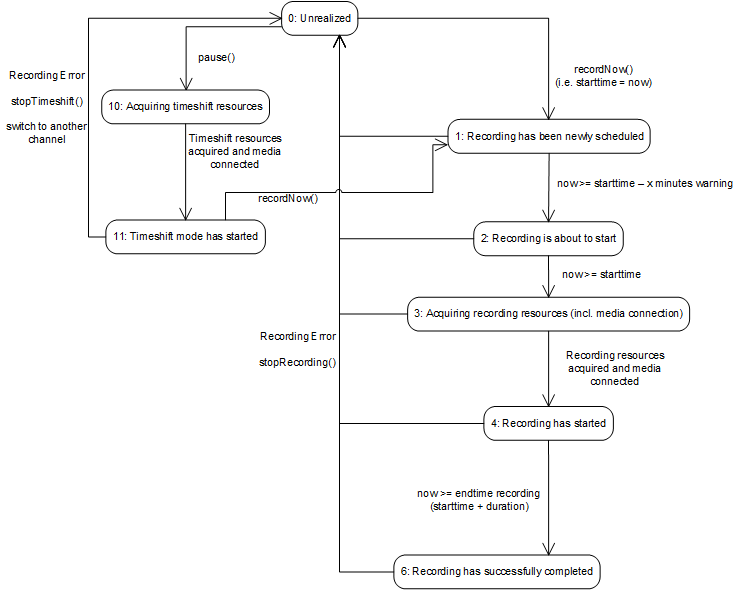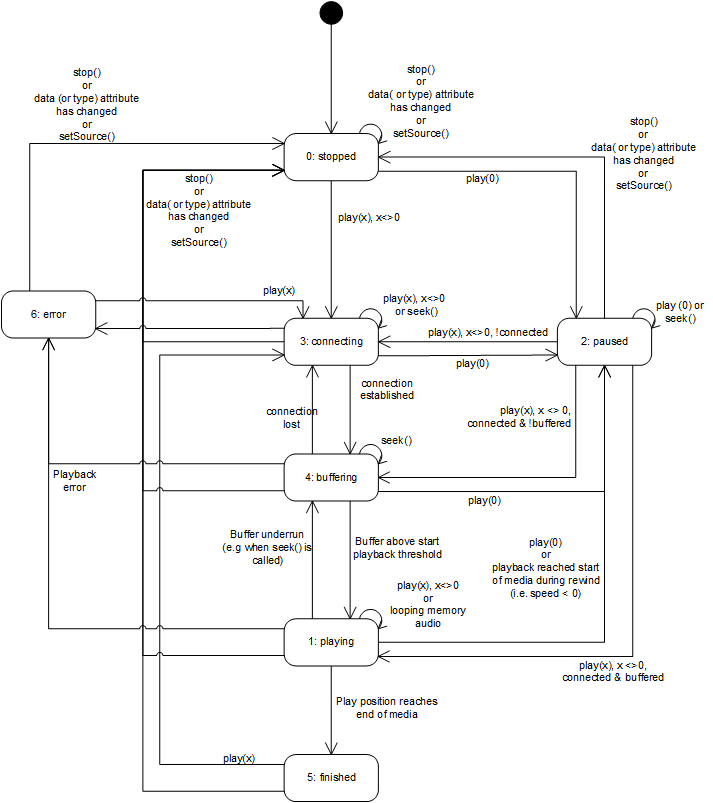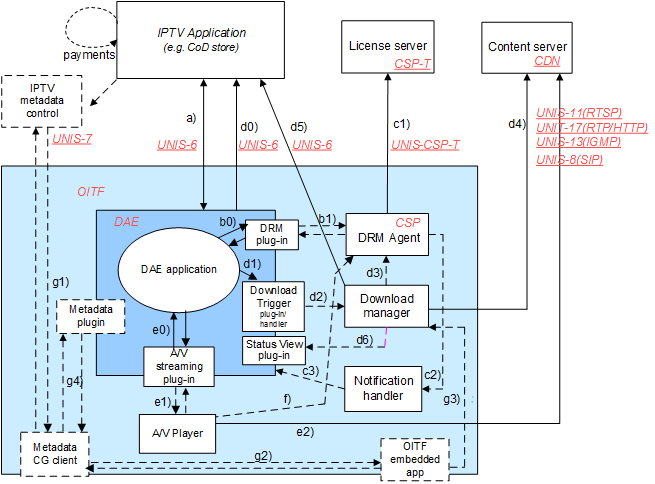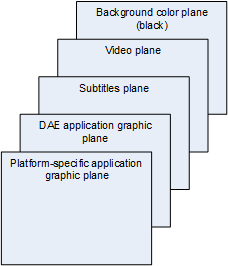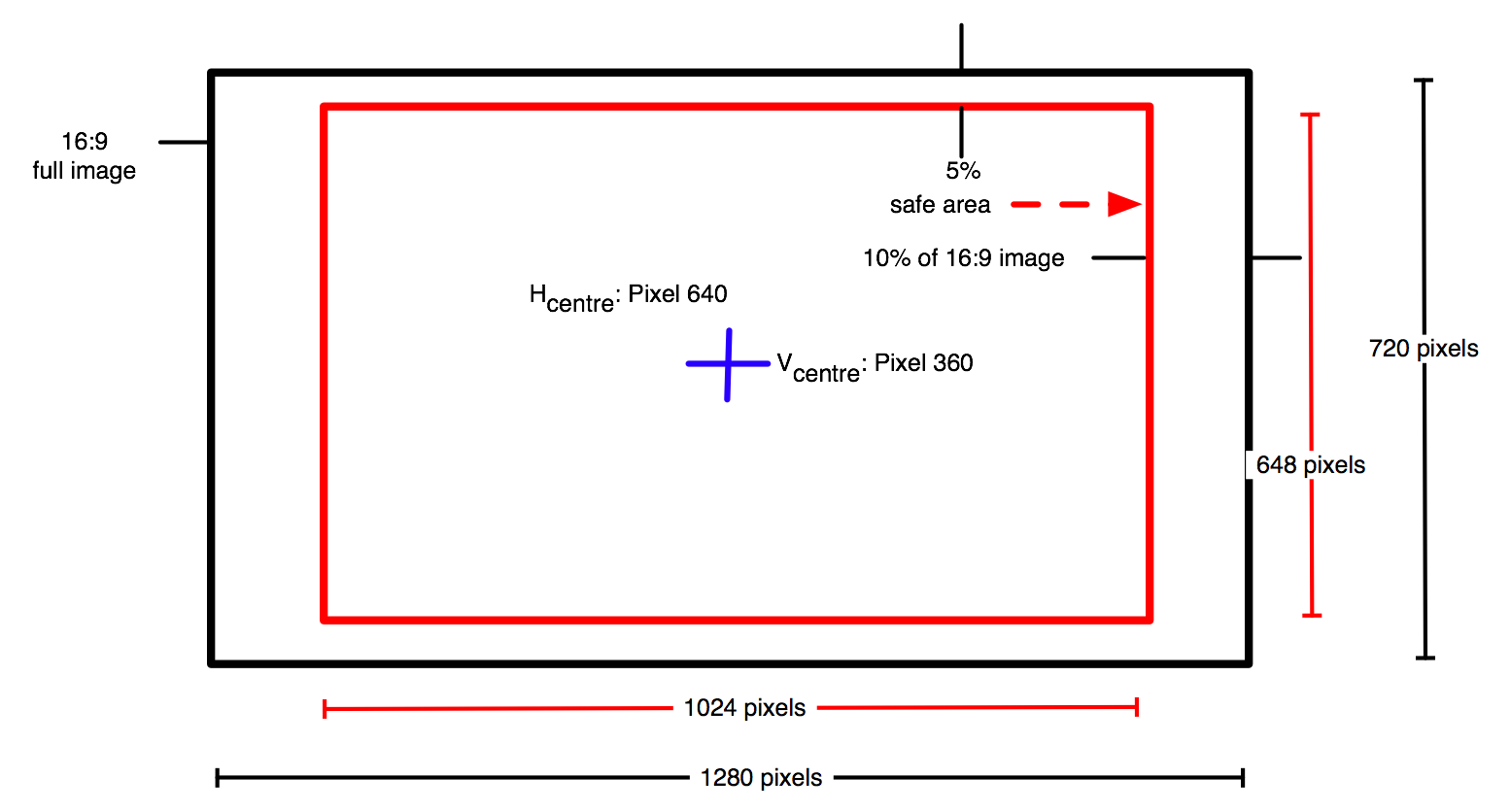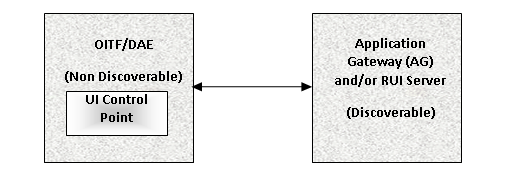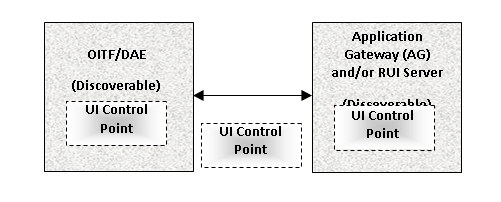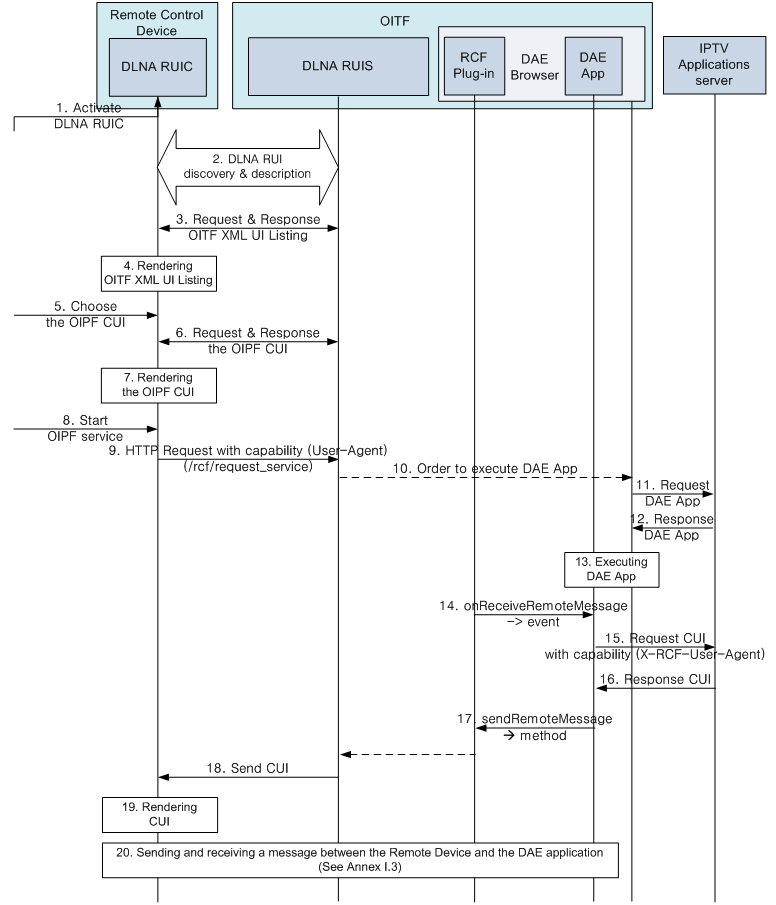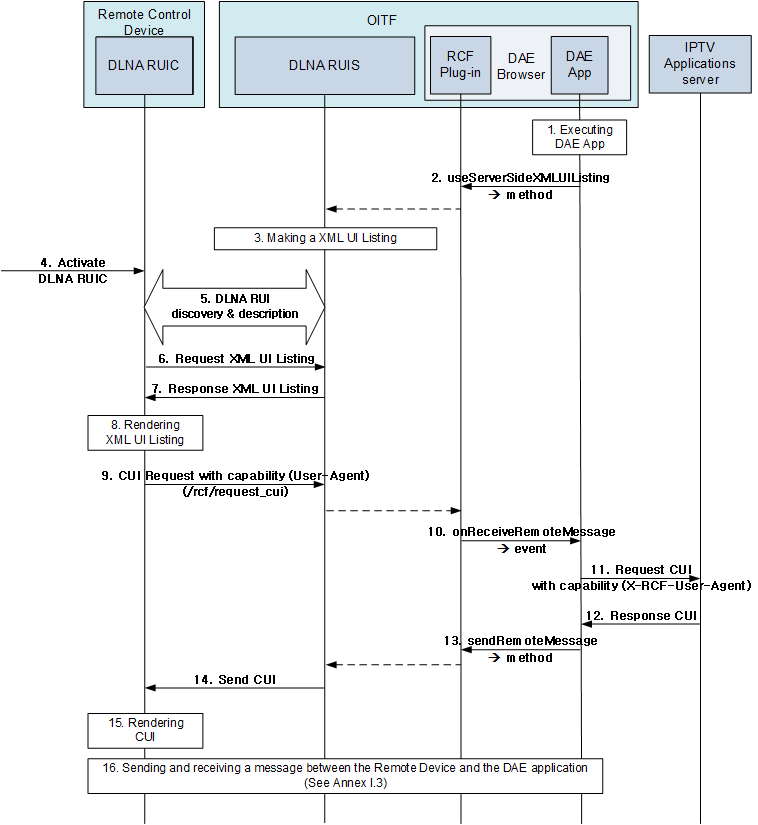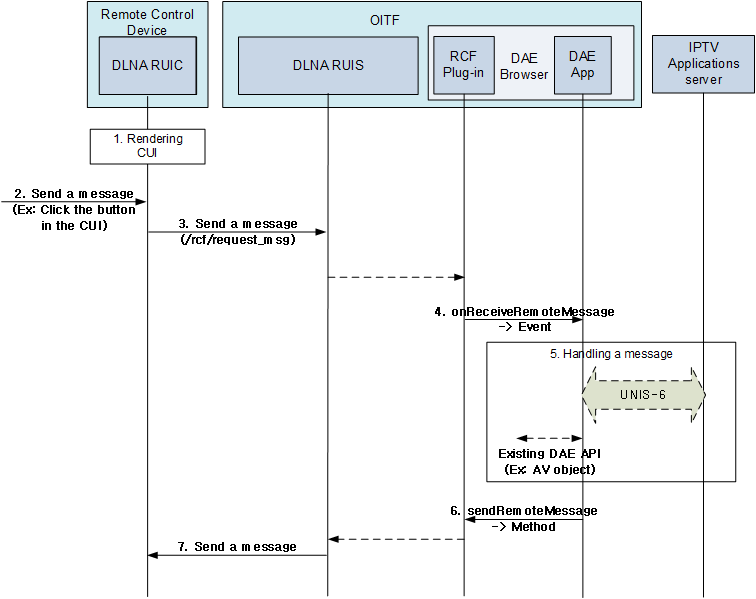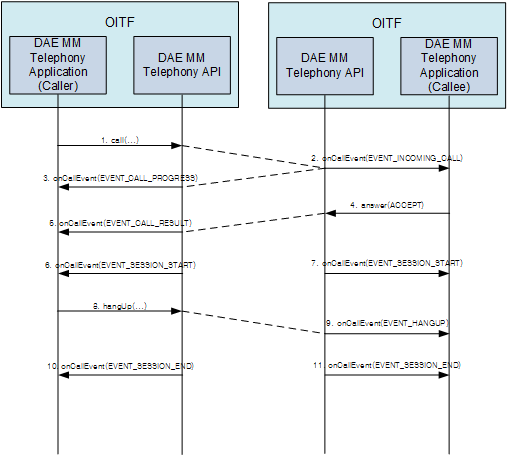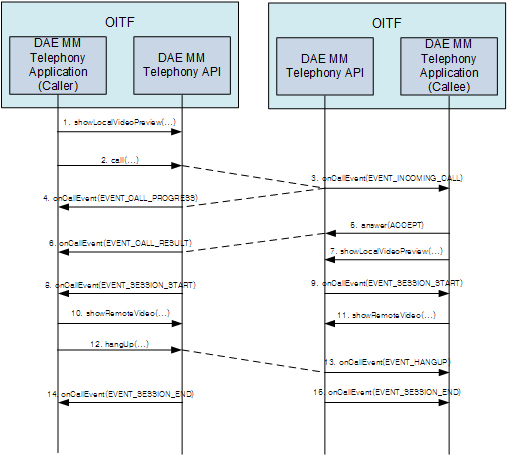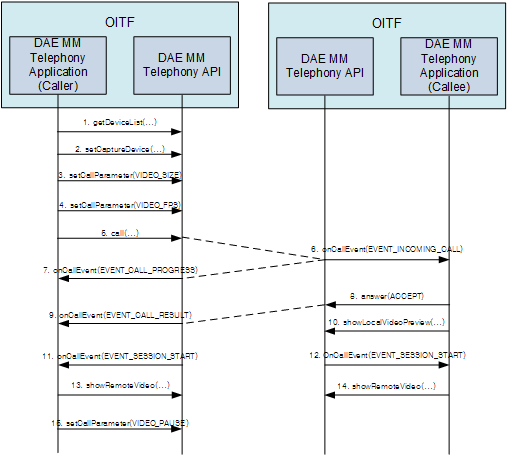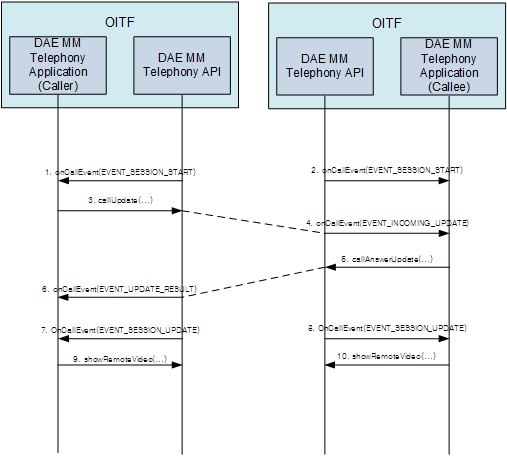DAE Overview
This specification builds on a selection of W3C specifications defined in [[.OIPF_WSTVP2]] with additions defined in this document in order to expose to an IPTV service provider the capabilities of any particular OITF.
Section of this document defines how to interpret [[RFC2119]] terms like "SHALL" in sections of this document included in a capability. In sections of this document which are not covered by capabilities, terms like "SHALL" apply as used in each section.
Architecture of DAE
The following diagram provides an overview of the OITF architecture in relation to this specification.
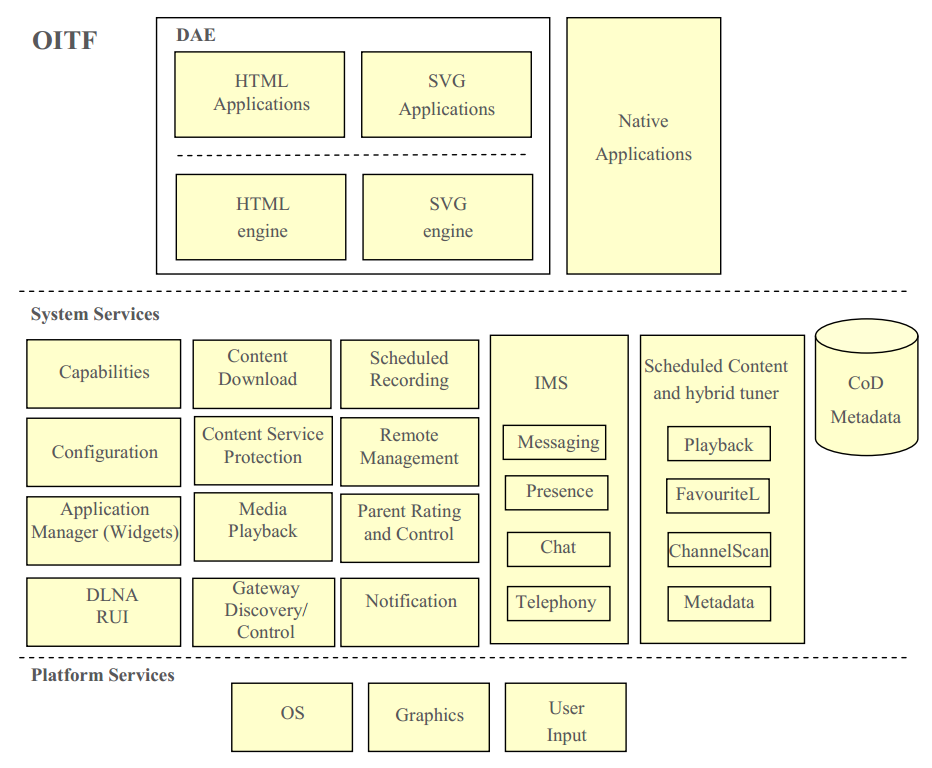
The various system services are described below:
Application Manager (Widgets): This service handles the starting and stopping of applications and the downloading, starting, stopping and removal of widgets. See sections , , , and of this specification.
Capabilities: This service handles terminal capabilities and exposing them to applications. See sections and of this specification.
CoD metadata: This service handles the downloading, storage and retrieval of CoD metadata. See section of this specification.
Configurations: This service handles reporting and changing device configuration and power management. See section of this specification.
Content Download: This service handles initiating downloading of content by applications, downloading the content and managing content once downloaded. See sections and of this specification.
Content Service Protection: This service handles content and service protection. See section of this specification.
DLNA RUI: This service enables a DAE application on an OITF to export a user interface to another device in the home as defined by the DLNA remote UI specification. See sections , and of this specification.
Gateway Discovery/Control: This service handles gateways, including discovery and managing information about them. See sections and of this specification.
IMS — Messaging, Presence, Chat, Telephony: This service handles IMS including messaging, presence, chat and telephony. See section of this specification.
Media Playback: This service handles playback of media including streaming on-demand, downloaded content and scheduled content which has been recorded. Live scheduled content is part of a different service. See sections and of this specification.
Notification: This service handles notifications from the network to the OITF. See section of this specification.
Parental Rating and Control: This service handles parental rating and control including reporting of changing of parental rating status and providing parental rating PIN codes. See sections , , and of this specification.
Remote Management: This service handles remote management when supported as a DAE application. See section of this specification.
Scheduled Content and hybrid tuner — playback, favourite lists, channel scan, metadata: This service handles scheduled content services whether these are delivered by IP or by a classical cable, satellite or terrestrial tuner in a hybrid device. See sections , , and of this specification.
Scheduled Recording: This service handles recording of scheduled content. See section of this specification.
NOTE: Native Applications are out of scope of the DAE specification.
Gateway Discovery and Control
This section describes how DAE applications discover the information of the gateway and subsequently interacts with the gateway. The discovery of the IG and AG by the OITF are defined in section 10.1 of [[.OIPF_PROT2]]. The discovery takes place prior to the DAE application being initialized. The information about the discovered gateways is made available to DAE applications through the application/oipfGatewayInfo embedded object. DAE applications can use this gateway information to interact with the discovered gateways (e.g. IG, AG, CSP gateway and so on). The application/oipfGatewayInfo embedded object SHALL be made accessible through the DOM with the interface as defined in section .
Access to the functionality of the application/oipfGatewayInfo embedded object is privileged and SHALL adhere to the security requirements defined in section .
Application Definition
This section defines what is meant by the concept of a 'DAE application'; which files and assets are considered to be part of a DAE application and how this relates to DAE application security and lifecycle.
A DAE application is either:
- An associated collection of documents (HTML or SVG where supported) from within a common boundary (see section for more details), or
- A Widget as specified in section .
While the application is loaded within the browser, an additional browser object (the oipfApplicationManager object), defined in section is present and accessible by the DAE application. The oipfApplicationManager object provides access to the Application class defined in section .
The difference between a DAE application and a traditional web page is that web pages are stand-alone with no formal concept of a group of pages or a context within which a group of pages are loaded and execute. For this reason, the definition and details of a DAE application focuses on the application execution environment and the additional capabilities provided to DAE applications. The next subsections describe some of the differences. Additional details about the DAE application lifecycle can be found in section .
Similarities between applications and traditional web pages
DAE applications are comprised of pages which are conceptually no different from traditional web pages. Both pages in a DAE application and traditional web pages can include the contents of other documents. These included documents can have a variety of types, including Cascading Style Sheets (CSS), JavaScript, SVG, JPEG, PNG and GIF.
A dynamic DOM, combined with XMLHttpRequest, permits AJAX-style changes to the current page in a DAE application or web page without necessarily replacing the entire document.
Differences between applications and traditional web pages
A DAE application provides shared context and state common to a number of pages — a concept which doesn't formally exist in the web. Loading and unloading pages within the context of a DAE application is the same as loading and unloading web pages.
The application context includes information about the state of an application from the platform's perspective — permissions, priority (for example, which to terminate first in the event of insufficient resources) and similar information that spans all documents within an application during the lifetime of that application.
An OITF MAY support the execution of more than one application simultaneously. Applications MAY share the same screen estate in a defined and controlled fashion. This differs from multiple web pages, which are typically handled through different browser “windows” or “tabs” and may not share the same screen estate concurrently (although the details of this behaviour are often browser-dependent). This also differs from the use of frames, which, apart from iframes, do not support overlapping screen estate. Where simultaneous execution of more than one application is supported, both foreground and background applications SHALL be supported simultaneously.
Where simultaneous execution of more than one application is supported, applications SHALL be recorded within a hierarchy of applications. Each object representing an application possesses an interface that provides access to methods and attributes that are uniquely available to applications. For example, facilities to create and destroy applications can be accessed through such methods.
The application tree
Where simultaneous execution of more than one application is supported, applications are organised into a tree structure. Using the createApplication() method as defined in section , applications can either be started as child nodes of the application or as a sibling of the application (i.e. added as an additional child of this application's parent). The root node of an application tree is created upon loading an initial application URI or by creating a sibling of an application tree's root node. An OITF MAY keep track of multiple application trees. Each of these individual application trees are connected to a hidden system root node maintained by the OITF that is not accessible by other applications.
Applications created while the DAE environment is running (e.g. as a result of an external notification) that are not created through createApplication() SHALL be created as children of the hidden system root node.
The application display model
Applications SHALL be displayed on the OITF in one of the application visualization modes as defined in section .
The mode used SHALL be determined prior to initialisation of the DAE execution environment and shall persist until termination or re-initialization of the DAE execution environment. The means by which this mode is chosen is outside the scope of this specification.
Each application has an associated DOM Window object and a DOM Document object that represents the document that is currently loaded for that application. Even “windowless” applications that are never made visible have an associated DOM Window object.
Manipulating an application's DOM Window object
Standard DOM Window methods are used to resize, scroll, position and access the application document (see section ). Many browsers restrict the size or location of windows; these restrictions SHALL NOT be enforced for windows associated with applications within the browser area. Any area of the display available to DAE applications may be used by any application. Thus, 'widget'-style applications can create a small window that contains only the application without needing to be concerned with any minimum size restrictions enforced by browsers.
The security model
Each application has a set of permissions to perform various privileged operations within the OITF. The permissions that are granted to an application are defined by the intersection of three permission sets:
- The permissions requested by the application, using the mechanism defined in section .
- The permissions supported by the OITF. Some permissions may not be supported due to capability restrictions (e.g. the permission_pvr permission will never be granted on a receiver that does not support PVR capability).
- The permissions that may be granted, as determined by user settings or configuration settings specified by the operator (e.g. blacklists or whitelists; see section for more information). This is a subset of (2), and may be different for different users.
Inheritance of permissions
Applications created by other applications (e.g. using the methods described in sections or ) SHALL NOT inherit the permissions issued to the parent application. The permissions granted to the new application will be defined by the mechanism specified in section .
When an application uses cross-document messaging (see the window.postMessage() method defined in HTML5 Web Messaging as referenced in [[.OIPF_WSTVP2]]) to communicate with another application, any action carried out in response to the message SHALL take place in the security context of the application to which the message was sent. Applications SHOULD take care to ensure that privileged actions are only taken in response to messages from an appropriate source.
Privileged application APIs
The privilege model implemented with applications is based upon requiring access to the Application object representing an application in order to access the privileged functionality related to application lifecycle management and inter-application communication.
Compromising the security
Since applications have access to Application objects, it is possible for applications to compromise the security of the framework by passing these objects to untrusted code. For example, an application could raise an event on an untrusted document and pass a reference to its Application object in the message. Where simultaneous execution of more than one application is supported, any calls to methods on an Application object from pages not running as part of an application from the same provider SHALL throw an error as defined in section .
Active applications list
Where simultaneous execution of more than one application is supported, the OITF SHALL maintain a list of application nodes ordered in a “most recently activated” order — the active applications list. This list is used by the cross-application event dispatch algorithm as defined in section and is not directly visible to applications.
An application is activated through calling the activateInput() method of the application node. This marks an application as active and SHALL insert the application at the start of the active application list (removing it from the list first if it is already present).
An application is deactivated through the deactivateInput() method of the application node. This marks an application inactive and SHALL remove it from the active application list.
The currently active application is the application at the start of the active application list.
This specification does not define any behaviour if more than one copy of the browser is executing.
Widgets
DAE Widgets are a specialization of DAE applications and share aspects with W3C Widgets.
W3C Widgets are standardized by the “Widgets 1.0 family of specifications” as described in section 1.4 of [[!Widgets-Packaging]]. Section of this document specifies which parts of W3C Widgets specifications are in supported by DAE Widgets. From here on, when using the word “Widget” we will refer to DAE Widgets as defined in this specification.
Widgets can be primarily seen as packaged DAE applications. Since they are packaged, it is possible to have a single download and installation on an OITF. Widgets may also be installed on an OITF via non-HTTP distribution channels and even over off-network channels (e.g. a USB thumb drive). Packaging also provides an easy way to deploy and/or update applications on the OITF when it is installed in the home. The packaging and configuration of a DAE Widget is described in section .
Since DAE Widgets are DAE Applications everything that is defined for a DAE Application is also applicable to a Widget unless specified. Furthermore Widgets have several specific features as defined in section .
Origin for Broadcast-delivered Documents
For documents that are delivered by an object carousel in a broadcast channel (as defined in section 4.1 of [[.OIPF_MEDIA2]], the following SHALL apply;
- For each broadcast channel, the OITF SHALL generate a unique origin as defined in [[!RFC6454]].
- These origins SHALL be of the form scheme/host/port tuple where the OITF does not use the same scheme for any documents other than those delivered by a broadcast object carousel.
- The origin SHALL be the one for the channel from which the document was loaded regardless of any subsequent channel changes
Specifically this origin SHALL be used with the Web Storage API as referenced in [[.OIPF_WSTVP2]].
Resource Management
This section describes how resources (including non-granular resources such as memory and display area) are shared between multiple applications that may be running simultaneously. Applications SHOULD be able to tolerate the loss of scarce resources if they are needed by another application, and SHOULD follow current industry best practises in order to minimize the resources they consume.
This specification is silent about the mechanism for sharing resources between DAE applications and other applications running on the OITF. In the remainder of this section and this document, the term application refers solely to DAE applications.
Application lifecycle issues
Where simultaneous execution of more than one application is supported, if an application attempts to start and not enough resources are available, the application with the lowest priority MAY be terminated until sufficient resources are available for the new application to execute or until no applications with a lower priority are running. Applications without a priority associated with them (e.g. applications started by the DRM agent, see section ) SHALL be assumed to have a priority of 0x7F.
Applications may register a listener for ApplicationUnloaded events (see section ) to receive notification of the termination of a child application, where simultaneous execution of more than one application is supported.
Failure to load an asset (e.g. an image file) or CSS file due to a lack of memory SHALL have no effect on the lifecycle of an application, but may result in visual artefacts (e.g. images not being displayed). Failure to load an HTML file due to a lack of memory MAY cause the application to be terminated.
Caching of application files
Application files MAY be cached on the receiver in order to improve performance; this specification is silent about the use of any particular caching strategy.
Memory usage
Applications SHOULD use current industry best practises to avoid memory leaks and to free memory when it is no longer required. In particular, applications SHALL unregister all event listeners before termination, and SHOULD unregister them as soon as they are no longer required.
Where available, applications SHALL use explicit destructor functions to indicate to the platform that resources may be re-used by other applications.
Applications MAY use the gc() method on the application/oipfApplicationManager embedded object to provide hints to the OITF that a garbage collection cycle should be carried out. The OITF is not required to act on these hints.
The LowMemory event described in section SHALL be generated when the receiver is running low on memory. The amount of free memory that causes this event to be generated is implementation dependent. Applications may register a listener for these events in order to handle low-memory situations as they choose best.
Instantiating embedded objects and claiming scarce system resources
The objects defined in section of this specification are embedded objects. These are typically instantiated through the standard DOM 2 methods for creating HTML objects or the oipfObjectFactory as defined in section .
All embedded objects as defined in section SHALL NOT claim scarce system resources (such as a hybrid tuner) at the time of instantiation. Hence, instantiation SHALL NOT fail if the object type is supported (and sufficient memory is available).
For each embedded object for which scarce resource conflicts may be a problem, the state diagram and the accompanying text define how to deal with claiming (and releasing) scarce system resources.
Once an OIPF embedded object has been instantiated, dynamic change of its MIME type which could cause the properties and methods associated with the object to change SHALL be ignored.
For instance, it is possible to change the MIME type of an A/V Control embedded object from video/mpeg to video/mp4 but it is not possible to change the MIME type of an OIPF embedded object from “application/oipfApplicationManager” to “application/oipfConfiguration”.
Media control
If insufficient resources are available to present the media, the attempt to play the media SHALL fail. For the video/broadcast object, this shall be indicated by a ChannelChangeError event with a value of 11 for the error state. For an A/V Control object, the error property shall take the value 3.
When the video/broadcast or A/V Control object either is instantiated in the DYNAMIC_ALLOCATION model or transitions to the DYNAMIC_ALLOCATION model, scarce resources such as a media decoder SHALL only be claimed following a call to the bindToCurrentChannel(), setChannel(), nextChannel() or prevChannel() methods on a video/broadcast object or the play() method on an A/V Control object. By implication, instantiating a video/broadcast or A/V Control object does not cause the media referred to by the object's data attribute to start playing immediately. See section for details of when scarce resources are released by a video/broadcast object and section when scarce resources are released by an A/V Control object.
Scarce resources can be claimed by the video/broadcast or A/V Control object at instantiation time by specifying the requiredCapabilities parameter. In this case the STATIC_ALLOCATION method is used and the scarce resources are held by the object until it is either destroyed or the release() method is called.
This specification is intentionally silent about handling of resource use by embedded applications including scheduled recordings.
Use of the display
A compliant OITF SHALL support at least one of the following application visualization modes for managing the display of applications:
- Multiple applications may be visible simultaneously, with each application having a full-screen window, with the OITF managing focus. Setting parts of an application to be transparent SHALL cause the following to be visible except where the application has drawn UI elements.
- firstly any applications with a lower Z-index
- secondly video (if the hardware supports overlay as per the
<overlay*>elements defined in section for the capability profiles)
In this mode, applications from the same service provider that are intended to run simultaneously SHOULD take care to co-ordinate their use of the display in order to ensure that important UI elements are not obscured.
- Multiple applications may be visible simultaneously, with the OITF managing the size, position, visibility and focus between applications.
- Only one application is visible at any time; switching to a different application either hides the currently-visible application (where simultaneous execution of more than one application is supported) or terminates the currently visible application (where simultaneous execution of more than one application is not supported). The mechanism for switching between applications is implementation-dependent. In this case, the show(), hide(), activateInput() and deactivateInput() methods of the Application object provide hints to the execution environment about whether the user should be notified that an application requires attention. The mechanism for notifying the user is outside the scope of this specification.
Applications SHALL be created with an associated DOM Window object, that covers the display area made available by the OITF to a DAE application. The size of the DOM Window can be retrieved through properties innerWidth and innerHeight of the DOM Window object.
Any areas of the browser area outside the DOM Window that become visible when it is resized SHALL be transparent — any video (if the hardware supports overlay as per the <overlay*> elements defined in section for the capability profiles) or applications (if multiple applications can be visible simultaneously) with a lower Z-index will be visible except where the application has drawn UI elements.
Broadcast-related and service provider related applications SHALL initially be created as invisible to avoid screen flicker during application start-up. Once loaded (as SHALL be indicated through an onload event handler), the application then typically calls the show() method of its parent Application object. Broadcast-independent applications SHALL initially be created as visible and need not call these methods.
If the application does not ever need to be visible, then its DOM Window object will never be shown. In that case, the application should take steps to avoid being formatted to reduce computation and memory overheads. This is typically accomplished by setting the default CSS style of the document's BODY element to visibility:hidden.
Because all applications have associated DOM Window objects, it is possible to make any application visible even if it is not normally intended to be visible. This is of particular benefit during debugging of hidden service type applications.
Application developers SHOULD explicitly set the background color of the application <body> and <html> elements.
Setting the background color to 'transparent' (e.g. using the CSS construct html, body { background-color: transparent; }) will allow the underlying video to be shown for those areas of the screen that are not obscured by overlapping non-transparent (i.e. opaque) children of the <body> element.
Changing the visibility of an application by calling method show() or hide() on the Application object SHALL NOT affect its use of resources. The application still keeps running and listens to events unless the application gets deactivated (see section ) or destroyed (see section ).
Cross-application event handling
As defined in the DOM Level 3 Events specification as referenced in [[!OIPF_WSTVP2]], standard DOM events are raised on a specific node within a single document. This specification extends the event capability of the OITF through cross-application events handling, but does not change the DOM2 event model for dispatching events within documents. Where simultaneous execution of more than one application is supported, an OITF SHALL implement the cross-application events and cross-application event handling model described in this section.
- An OITF SHALL implement the following cross-application event handling model. Cancelling the propagation of an event in any phase SHALL abort further raising of the event in subsequent phases: If an event is eligible for cross-application event handling (see below for more information) and is targeted at a node in the most recently activated application, then dispatch the event to that node using the standard DOM bubbling/capturing of events. Default actions normally taken by the browser upon receipt of an event SHALL be carried out at the end of this step, unless overridden using the existing DOM methods (i.e. using method preventDefault()).
- If the cross-application event is not prevented from being propagated beyond the document root node of the application by using the existing DOM methods, the event is dispatched to other active applications in the application hierarchy using the active applications list described in section . The OITF SHALL iterate over the applications in the active application list, from most recently activated to least recently activated, dispatching the event to the Application object of each application in turn. Note that the event SHALL NOT be dispatched to the document, and default browser action SHALL NOT be carried out during this phase. Cancelling the propagation of an event in this phase SHALL abort further raising of the event in subsequent applications.
Event listeners for cross-application events are registered and unregistered using the same mechanism as for DOM2 events. Listeners for cross-application events may be registered on the Application object as well as on nodes in the DOM tree.
The following events are valid instances of cross-application events and are applicable for cross application event handling:
| System event | Description |
|---|---|
KeyPress | Generated when a key has been pressed by the user. May also be generated when a key is held down during a key-repeat. |
KeyUp | Generated when a key pressed by the user has been released. |
KeyDown | Generated when a key has been pressed by the user. |
The KeyPress, KeyUp and KeyDown events are all targeted cross-application events. The events are targeted at the node that has the input focus.
All events dispatched using the standard dispatchEvent() method are normal DOM events, not cross-application events. As defined in HTML5 Web Messaging as referenced in [[.OIPF_WSTVP2]], the OITF SHALL support the window.postMessage() method for cross-document messaging. The method takes two arguments; a message (of type String) to be dispatched and the targetOrigin, which defines the expected origin (i.e. domain) of the target window, or “*” if the message can be sent to the target regardless of its origin. The target of the event is the “window” of a specific application. Applications can use this method to send events to other applications. The receiving application MAY receive those events and interpret them, or MAY dispatch them in its DOM using standard DOM dispatchEvent() methods.
The visibility of an application SHALL NOT affect the cross-application event handling algorithm as defined above — an active application SHALL receive cross-application events even when it is not visible.
Incoming key events are dispatched using the cross-application event handling algorithm as defined above.
NOTE: This event dispatch model enables key events to be dispatched to multiple applications. Applications wishing to become the primary receiver for key events SHOULD call Application.activateInput(). Even though Application.activateInput() is called, another application may subsequently be activated. In order to ensure that sensitive key input (e.g. PINs or credit card details) is limited only to the application it is intended for, applications SHOULD check that they are the primary receiver of the key events (using the Application.isPrimaryReceiver property and/or the ApplicationPrimaryReceiver and ApplicationNotPrimaryReceiver events defined in section ) and SHOULD 'absorb' key events by calling the stopPropagation() method on the DOM2 key event.
Behaviour of the BACK key
OIPF applications may use the methods on the History object to navigate the history list. The history list SHALL NOT go back beyond the initial page of an OIPF application.
If a remote features a “back” or “back up” key, or one offering similar functionality, the OITF SHALL handle this key as described below:
Tuner resources
Tuners can be used for recording, scanning or watching broadcast channels (e.g. DVB-T). The priority relating to resource management is as follows. Recording have the highest priority, viewing a channel has the lowest priority. A record request SHALL not be automatically interrupted by a viewing a channel or a scan request. Note to free the tuner for viewing requires interrupting the recording first.
Parental access control
The present document permits a number of different approaches to parental access control.
- Enforcement in the network.
An IPTV service provider MAY manage parental access control completely in the network. Applications running on application servers back in the network MAY decide to block access to content or arrange a DAE application to ask for a PIN code as necessary. This approach can apply to any kind of content - streaming on-demand content, IP broadcast content and to downloaded content.
No specific support is needed for this approach in the specification.
- Enforcement in the OITF CSP / CSPG for protected MPEG-2 TS content
IPTV service providers MAY use the content protection mechanism for protected content to enforce access control to protected content. If used, this enforcement will happen in the OITF and in some cases in the CSP Gateway as well. In this approach, the content protection mechanism in the OITF would ask for PIN codes as needed.
The OITF CSP/CSPG-based enforcement of this approach and link to DAE API and events are defined in:
- Section 4.1.5.1 of [[.OIPF_CSP2]], for CSP terminal centric approach,
- Sections 4.2.2, 4.2.3.4.1.1.5 and 4.2.3.4.1.1.6 of [[.OIPF_CSP2]] for CI+ CSP Gateway centric approach
- Sections 4.2.2 and 4.2.4.5.1 of [[.OIPF_CSP2]] for DTCP-IP CSP Gateway centric approach
- enforcement in the OITF
An OITF MAY enforce parental access controls itself. Examples include embedded applications offering access to;
- IP delivered content based on information delivered to the metadata CG client.
- classical broadcast content in hybrid OITFs
- content delivered to the OITF (either streaming or downloaded)
In approaches b) and c), PIN dialogs would be generated by code forming part of the OITF implementation. The APIs in section provide some control over these dialogs. The PIN would typically be configured by an embedded application but MAY also be configured by a DAE application using the optional APIs defined in section “” of the present document.
These approaches b) and c) are reflected in a number of failure modes as defined in the following sections of the specification;
- For broadcast channels (both IP and hybrid), in section "", see onChannelChangeError where
errorState3 is defined as "parental lock on channel" - Parental rating errors and parental rating changes during playback of A/V content through the AV Control APIs defined in section and the video/broadcast object are reported according to the mechanism described in section “” and section “” respectively.
NOTE: Due to the variation in regulatory requirements and deployment scenarios, the present document is intentionally silent about which of these approaches or combination of approaches is used.
Content Download
The requirements in this section apply if the <download> element has been given value “true” in the OITF's capability profile as specified in section .
Download manager
An OITF SHALL support a native download manager (i.e. “Content Download” component) to perform the actual download and storage of the content, and which allows the user to manage (e.g. suspend/resume, cancel) and monitor the download, in a consistent manner across different service providers. The download manager SHALL continue downloading as a background process even if the browser does not have an active session with the server that originated the download request anymore (e.g. has switched to another DAE application), even after a device power-down or network failure, until it succeeds or the user has given permission to terminate the download. (see section on HTTP Range support to resume HTTP downloads after a power/network failure).
The native download manager SHALL be able to offer a visualization of its status through the application/oipfStatusView embedded object as defined in section .
If the attribute manageDownloads of the <download> element in the client capability description is unequal to “none”, the native download manager SHALL offer control over the active downloads through the JavaScript API defined by the application/oipfDownloadManager embedded object in section .
NOTE 1: Once sufficient data of the content has been downloaded, the content MAY be played back using a native application, and MAY be played back using an A/V Control object. In the latter case, see method setSource() in section for more information.
NOTE 2: Annex clarifies the content download usage scenario in more detail.
Content Access Download Descriptor
An OITF SHALL support parsing and interpretation of the Content Access Download Descriptor document format with the specified semantics, syntax and MIME type as specified in Annex .
Triggering a download
An OITF SHALL support a non-visual embedded object of type “application/oipfDownloadTrigger”, with the JavaScript API as defined in sections and to trigger a download.
The following subsections define some details about the different ways of triggering a download.
Using the registerDownload() method
The registerDownload() method takes a Content Access Download Descriptor as one of its arguments and passes it to the underlying native download manager in order to trigger a download. The following requirements apply:
- The Content Access Download Descriptor MAY be created in JavaScript or MAY be fetched using
XMLHttpRequest. To this end the OITF SHALL pass the data inside the content access download descriptor into theXMLHttpRequest.responseXMLproperty in JavaScript for further processing, if the OITF encounters an HTTP response message with the Content-Type of “application/vnd.oipf.ContentAccessDownload+xml”, as the result of an XMLHttpRequest.NOTE: The behaviour in other cases when the OITF encounters an HTTP response message with the Content-Type “
application/vnd.oipf.ContentAccessDownload+xml”, for example whilst following a link as specified by an anchor element (<a>), is not specified in this document. - If the OITF supports a DRM agent with a matching
DRMSystemIDas per section , the OITF SHALL pass included DRM-information as part of the<DRMControlInformation>elements of a content-access download descriptor to the DRM agent. - If the content access descriptor contains multiple content items to be downloaded, then all items are considered to belong together. Therefore, the download of each individual content item has the same download identifier in that case (whereby the
ContentIDmay be used for differentiation). The order by which the items are downloaded is defined by the OITF.
Using the registerDownloadURL() method
The registerDownloadURL() method takes a URL as one of the arguments and passes it to the underlying native download manager in order to trigger a download. The URL MAY point to any type of content. The URL MAY also point to a Content Access Download Descriptor (i.e. with argument contentType having value “application/vnd.oipf.ContentAccessDownload+xml”). In that case, the method returns a download identifier. The OITF will then fetch the Content Access Download Descriptor, after which the same must happen as if method registerDownload() as defined in section with the given Content Access Download Descriptor as argument was called.
Using the optional registerDownloadFromCRID() method
The registerDownloadFromCRID() method is an optional method as defined in section and takes a CRID as one of its arguments that is passed to the underlying native download manager in order to trigger a download.
General behaviour regarding triggering a download
The following are general behavioural requirements apply to triggering downloads:
- Fetching the content will typically be initiated immediately. However, the OITF MAY defer the download to a later time.
- An OITF SHOULD offer an easy way to continue the UI interaction with the server from which a download has been initiated, e.g. allowing him/her to continue browsing on the page that triggered the download.
- An OITF SHOULD inform the user if the content-type of a content item being retrieved cannot be interpreted by the OITF.
Download protocol(s)
The OITF SHALL support the HTTP protocol for download as specified in section 5.3.4 of [[!OIPF_PROT2]]. In addition, the OITF SHALL support the following requirements:
- As specified in section 5.3.4 of [[.OIPF_PROT2]], if a server offers a content item for download using HTTP, the server SHALL make sure that HTTP Range requests as defined in [[!HTTP]] are supported for HTTP GET requests to the URI of that downloadable content item, in order to be able to resume downloads (e.g. after power or network failure).
- If the OITF receives an HTTP 404 “File Not Found” status code, the OITF SHALL stop its attempts to resume the download, and go to a “Failed Download” state. The handling of other error codes is implementation dependent.
- If after downloading a content item the size of the downloaded content item does not match the indicated size parameter or the value for the optional attribute “MD5Hash” of the given
<ContentURL>does not match the hash of the downloaded content, the OITF SHOULD remove the downloaded content item.
Integration with download protocols other than HTTP are not specified in this document.
Streaming CoD
This section defines the content-on-demand streaming interfaces for both DRM-protected and non-DRM protected content.
Unicast streaming
This specification defines 3 mechanisms by which a reference to content can be passed from a DAE application to the OITF.
- By setting the
dataproperty of a A/V Control object as defined in section to the reference. The application SHALL set thetypeattribute to the MIME type of the content referred to by the value of the data attribute to provide a hint about the expected content type, in order for the browser to instantiate the proper object to play the content. - By setting the
srcattribute of a<video>element to the reference - By including the reference in the
<ContentURL>element of a Content Access Streaming descriptor as defined in section and then setting thedataproperty of an A/V Control object as defined in section to be a reference to that Content Access Streaming Descriptor. In this case the application SHALL set thetypeattribute to “application/vnd.oipf.ContentAccessStreaming+xml”.Example:
<object id="d1" data=http://www.openiptv.org/fetch?contentID=25
type="application/vnd.oipf.ContentAccessStreaming+xml" width="200" height="100"/>
This specification defines five different possible formats for a reference to unicast streaming content;
- A Public Service Identifier (PSI) as defined in Protocol Specification [[.OIPF_PROT2]].
- An HTTP URL directly referencing the content to be streamed.
- An RTSP URL directly referencing the content to be streamed.
- An HTTP or HTTPS URL referencing a HAS MPD
- An HTTP or HTTPS URL referencing a MPEG DASH MPD
All of the mechanisms that an OITF supports SHALL be supported with all formats of a reference that an OITF supports.
HTTP Adaptive Streaming
If the OITF supports HAS content then it SHALL support the MIME type as specified for the Media Presentation Descriptor (MPD) in [[!TS26234]], i.e. “video/vnd.3gpp.mpd”, and in the HAS specification [[.OIPF_HAS2]]. If the OITF supports MPEG DASH content then it SHALL support the MIME type as specified for the Media Presentation Descriptor (MPD) in Annex C of [[!DASH]], i.e. “application/dash+xml”.
The MPD SHALL be retrieved by specifying a URL. To this end, the OITF SHALL fetch the MPD from the URL, after which the MPD SHALL be interpreted and an initial (set of partial) Representation(s) selected.
When the URL is passed to the OITF in the data property of a A/V Control object as defined in section , and either a HAS MPD is not valid according to the XML Schema and semantics as defined in Annex A of [[.OIPF_HAS2]] or an MPEG DASH MPD is not valid according to the XML Schema and semantics as defined in [[!DASH]] or [[.OIPF_HAS2]], then the A/V Control object SHALL go to play state 6 ('error'), with error value 4 ('content corrupt or invalid').
If the OITF supports HAS content then HAS SHALL also be supported through the video/broadcast object for live content. If the OITF supports MPEG DASH content then MPEG DASH SHALL also be supported through the video/broadcast object for live content. This SHALL be done using Channel objects returned from calls to the createChannelObject( Integer idType, Integer onid, Integer tsid, Integer sid, Integer sourceID, String ipBroadcastID ) method where the idType argument is ID_IPTV_URI and the ipBroadcastID argument is a URL which points to an MPD for Scheduled Content (live streaming) over HTTP.
Multicast streaming
If an OITF has indicated support for IPTV channels through a <video_broadcast> element with type ID_IPTV_* (as defined in section ) the OITF SHALL support passing a content-access descriptor through the 'contentAccessDescriptorURL' argument of the 'setChannel'-method of the video/broadcast object (as defined in section ). If the content-access descriptor includes DRM information, the OITF SHALL pass this information to the DRM agent.
Scheduled Content
If an OITF has indicated support for playback and control of scheduled content through the <video_broadcast> element, then it SHALL support the “video/broadcast” embedded object defined in section . In addition, it SHALL adhere to the requirements for conveyance of the channel list as specified in section . To protect against unauthorized access to the tuner functionality and people's personal favourite lists, the OITF SHALL adhere to the security model requirements as specified in section , in particular the tuner related security requirements in section .
NOTE: This section and section are focused on control and display of scheduled content received over local tuner functionality available to an OITF. The term “tuner” is used here to identify a piece of functionality to enable switching between different types of scheduled content services that are identified through logical channels. This includes IP broadcast channels (using the mechanisms for Scheduled Content defined in [[.OIPF_PROT2]]), as well as traditional broadcast channels received over a hybrid tuner.
NOTE 2: The APIs in this section allow for deployments whereby the channel line-up and favourite lists for broadcasted content are managed by the client, the server, or a mixture thereof.
Conveyance of channel list
To enable a service to control the tuner functionality on an OITF, the OITF needs to convey the channel list information that is managed by native code on the OITF device to the service (either the channel list information is provided locally on the OITF via JavaScript, or the channel list is communicated directly to a server). This information includes the list of uniquely identifiable channels that can be received by the physical tuner of a hybrid device, including information about how the channels are ordered and whether or not these channels are part of zero or more favourite lists. It also includes the channel line-up and the favourite lists that MAY be managed by an OITF for IP broadcast channels.
The API supports two methods of conveying the channel list information to a service:
- Method 1: through JavaScript, by using the method “getChannelConfig()”, as defined in section .
- Method 2: through an HTTP POST message that is sent upon the first connection to a service that requires tuner control, as defined in section .
An OITF SHALL support method 1, and SHOULD support method 2.
If an OITF conveys the channel list information using the HTTP POST message defined in method 2, then the server SHALL, if it supports method 2, receive the conveyed channel list information and SHOULD rely on this information for the purpose of exerting tuner control. If a service supports using the channel list information sent through the HTTP POST method to exert tuner control , the server SHALL indicate this compatibility with method 2 using the postList attribute specified in section (i.e., <video_broadcast postList="true">true</video_broadcast>), in the server capability description.
If the server does not support method 2, the service SHALL rely on the getChannelConfig() method defined in section to access the channel list information. If an OITF does not support method 2, the HTTP message of the first connection to the service that requires tuner control SHALL be an HTTP GET message with an empty payload and the service SHALL instead rely on the getChannelConfig() method defined in section to access the channel list information. If support for method 2 is indicated by both the OITF and the server (through respective capability exchanges), the OITF SHALL convey the channel list information using method 2.
If an OITF does not manage/maintain the channel line-up (i.e. does not have a locally stored channel line up), the getChannelConfig() method described in section SHALL return null, and the HTTP message described in section SHALL be an HTTP GET message with an empty payload. In that case, the application MAY use the createChannelObject() method as defined in section to create channel objects that can be used on subsequent setChannel() requests, and in this way can manage/maintain its own channel list.
NOTE: conveyance of the channel list SHALL adhere to the security model requirements as specified in sections and .
Method 1: JavaScript method “getChannelConfig()”
The OITF SHALL support method “getChannelConfig()” as defined in section for the video/broadcast embedded object. This method returns a ChannelConfig object as defined in section .
Method 2: HTTP POST message
If an OITF supports sending the channel list through HTTP POST and a server has indicated that it uses the posted channel list information to exert control of the tuner functionality of an OITF (i.e. using attribute postList="true" in the server capability description) for a particular service, then the OITF SHALL issue an HTTP POST over TLS if it decides to connect to that service. The body of the HTTP POST over TLS request SHALL contain the Client Channel Listing, which SHALL adhere to the semantics, syntax and XML Schema that are defined for the Client Channel Listing in Annex . The server SHALL silently ignore unknown elements and attributes that are part of the Client Channel Listing.
The server SHALL return a HTML document.
If the favourite lists are not (partially) managed by the OITF, the Client Channel Listing SHALL neither contain the “FavouriteLists” nor the “CurrentFavouriteList” element.
Conveyance of channel list and list of scheduled recordings
This section and the following sections SHALL apply to OITFs that have indicated <recording>true</recording> as defined in section in their capability profile.
To enable a service to schedule recordings of content that is to be broadcasted on specific channels, the OITF needs to convey the channel list information that is managed by the native code on the OITF. This information typically includes the channel line-up of the tuner of a hybrid device. The conveyance of channel list information and scheduled recordings is based on the same two methods of conveying the channel list information to a service as defined in section :
- Method 1: through JavaScript, by using the method “getChannelConfig()”. To this end, the OITF SHALL support method “getChannelConfig()” as defined in section for the application/oipfRecordingScheduler object.
- Method 2: through an HTTP POST message as defined in section that is sent upon the first connection to a service that has indicated that it requires control of the recording functionality and that has indicated compatibility with method 2 using the
postListattribute specified in section (i.e.,<recording postList="true">true</recording>), in the server capability description for a particular service.
An OITF SHALL support method 1, and SHOULD support method 2. If support for method 2 is indicated by both the OITF and the server (through respective capability exchanges), the OITF SHALL convey the channel list information using method 2. Otherwise, the HTTP message of the first connection to the service that requires tuner control SHALL be an HTTP GET message with an empty payload.
If a server has indicated that it requires control of both the tuner functionality and the recording functionality available to an OITF (i.e. by including both <video_broadcast> and <recording> with value true in the OITF's capability description), the body of the HTTP POST message SHALL contain a single instance of the Client Channel Listing whereby the <Recordable> element defined in Annex SHALL be used to indicate whether channels that can be received by the tuner of the OITF can be recorded or not.
If an OITF does not manage the channel line-up, the getChannelConfig() method described in section SHALL return null, and the HTTP message described in section SHALL be an HTTP GET message with an empty payload.
In addition, the OITF SHALL also support method getScheduledRecordings() as defined in . This method returns a ScheduledRecordingCollection object, which is defined in section .
Note that the conveyance of the channel listing and the scheduled recordings is subject to the security model requirements specified in section , and in particular the recording related security requirements in section .
DLNA RUI Remote Control Function
This section describes the DLNA RUI RCF (Remote Control Function) and the interactions between the different entities involved. It builds on the RUI feature defined by the DLNA Networked Device Interoperability Guidelines (August 2009) [[!DLNA]] and shows how the DLNA RUI can be integrated into an OITF and used by DAE applications.
The DLNA RUI RCF is the feature that enables a Remote Control Device to be able to control the OITF or a DAE application running on it, from that Remote Control Device. To support this feature, a Remote Control Device SHALL support the DLNA RUIC function and an OITF SHALL support the DLNA RUIS function (as defined in section ).
The DLNA RUI RCF provides two main features:
- Providing a Control UI to the Remote Control Device.
- The Control UI is a CE-HTML document through which the user will control the OITF directly or a DAE application on the OITF. There are two options based on the origin of the Control UI for sourcing it as follows:
- Sourcing the Control UI from the OITF itself.
- Sourcing the Control UI from an IPTV Applications server via the OITF.
- The Control UI is a CE-HTML document through which the user will control the OITF directly or a DAE application on the OITF. There are two options based on the origin of the Control UI for sourcing it as follows:
- Interactions to exchange control messages and results
- The Control UI in the DLNA RUIC sends control messages to the OITF or DAE application and receives the corresponding results.
The following sections will introduce the interfaces between the entities that support the DLNA RUI RCF.
Interfaces used by the DLNA RUI Remote Control Function
This section describes interfaces related to the DLNA RUI RCF. There are three entities (Remote Control Device, OITF and IPTV Applications server) that communicate with each other through the interfaces described in Figure .
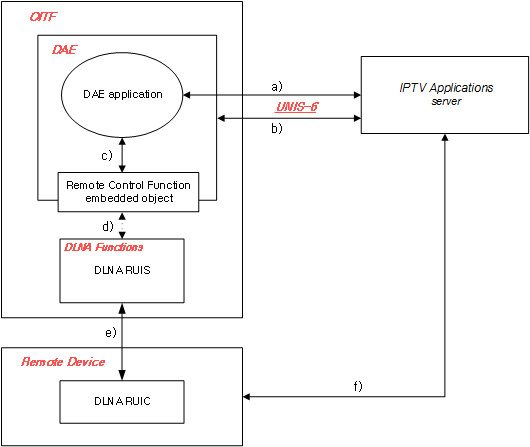
Figure shows the entities in the OIPF Architecture involved in the DLNA RCF and the interfaces between them.
The dotted line “d)” between the RCF embedded object and the DLNA RUIS indicates that it is a local interface and hence not defined by this specification. The detailed behaviour of each interface is defined as follows:
- Interface a)
This interface is used to retrieve a Control UI from an IPTV Applications server by using XMLHttpRequest object (the Control UI retrieved through interface a) will be delivered to DLNA RUIC via interfaces c), d) and e), sequentially). - Interface b)
This interface is used by the DAE browser to retrieve a DAE application containing an RCF object when the DLNA RUIC requests a DAE application to execute in the OITF. - Interface c)
The DLNA RUI RCF APIs use this interface to enable a DAE application to get the request originating from the DLNA RUIC, through an event dispatched by the OITF, and send the corresponding response or any other information to the DLNA RUIC via the DLNA RUIS. - Interface d)
This is a local interface that is used to pass messages between an RCF object in a DAE application and the DLNA RUIS. - Interface e)
This is a DLNA RUI compatible interface which provides device discovery, sending/receiving HTTP messages and notifications.
When the DLNA RUIC is activated by a user, the DLNA RUIC searches for a DLNA RUIS and does a capability exchange. Then, the DLNA RUIC retrieves the XML UI Listing from the DLNA RUIS and displays it to the user. When the user chooses one of the Control UIs, the DLNA RUIC retrieves the selected Control UI from the DLNA RUIS in the OITF.
The Control UI may send an HTTP request to deliver a message (for example, plays an AV content) and receive a response from the DLNA RUIS.
This interface is also used for the DLNA RUIS to send a 3rd party notification defined in section 5.6.1 of [[!CEA-2014-A]]. - Interface f)
This interface is used by the selected Control UI (CE-HTML document) to retrieve resources (For example, images, CE-HTML documents, or css or JavaScript files) directly from the IPTV Applications server.
Power Consumption
The power states described in this section relate to states exposed to the DAE application. There may be other states supported by the OITF which are not described here.
The OITF will be in one of a number of power states. Its default state is “off” which consumes no power. The OITF SHALL support an “on” state where it is running in normal operation. The OITF SHALL support at least one standby state where nothing is being output to the display but power is consumed. An OITF may support two different standby states, “active standby” and “passive standby”. An OITF in the “passive standby” state has the smallest possible power consumption (for example, average under 1W) which may be in line with European Commission Code of Conduct, US Energy Star or other regional requirements. In this state the IR listener and wakeup clock MAY be active but no DAE application is active. The IR listener allows the user to turn on the OITF using a remote control. A DAE application MAY use the wakeup clock to schedule the OITF enter the “active standby” state, for example to perform a recording.
Note there may be different levels of “active standby” state but the assumption is that, at least, nothing is being output to the display and one or more DAE applications may execute in the background.
The following explanation describes the behaviour of the OITF when transitioning between the mentioned states and how a DAE application is affected.
A DAE application SHALL be able to execute in the “on” and “active standby” states but SHALL NOT be able to execute in the “off” or “passive standby” states.
When an OITF is turned “on” from an “off” state a DAE application has to be explicitly selected by the user to be executed or the OITF has identified a DAE application to be auto-started. A DAE application has no direct control if it shall auto-start or not and this is left for the OITF to manage. A DAE application MAY auto-start if the Service Discovery and Selection has taken place and the user has selected a service provider.
When an OITF changes to an “off” or “passive standby” state from an “on” or “active standby” state, the DAE application SHALL get an ApplicationDestroyRequest event. The DAE application has an opportunity to take a final action and gracefully quit or it shall be killed forcibly.
DAE application wake-up support
The OITF MAY support wake-up requests from a “passive standby” state. There are two types of wake-up requests, one on an individual DAE application and one on the OITF. The supported wakeup is indicated in the power consumption capability information.
Single DAE application wakeup
The OITF MAY support wake-up requests for individual DAE applications when in “passive standby”. Similar to a scheduled recording, a DAE application may need to execute at a predetermined time. At the wake-up point the DAE application executes and when it completes its task returns to a “passive standby” state by exiting.
There SHALL only be one wake-up request per DAE application. There MAY be multiple wake-up requests from different DAE applications which SHALL execute independently. The OITF SHALL silently ignore all wake-up requests whose timers expire when it is not in the “passive standby” state.
When the DAE application terminates and the OITF changes to an “active standby” or “on” state for other reasons than a wake-up request the OITF SHALL NOT change power states.
Through capability information it is possible to determine if wake-up and standby modes are supported by OITF.
This is an example of how a DAE application may setup a wake-up request in OITF.
Precondition: The DAE application is actively running and the OITF is either in “on” or “active standby” states.
- End user selects to go into “passive standby” natively.
- An
ApplicationDestroyRequestevent is generated - The DAE application calls the prepareWakeupApplication() method and sets a token, time for wake-up and URI associated with the DAE application. The DAE application then quits, e.g. by calling destroyApplication() on its parent Application object.
- The OITF goes into “passive standby” state.
- When the wake-up time triggers, the OITF changes to “active standby” and the DAE application is initiated with the URI specified in the prior call to prepareWakeupApplication().
- The DAE application then runs clearWakeupToken() to get the token set in the prior call to prepareWakeupApplication().
- The DAE application executes.
- Once the DAE application completes execution it shall exit. The OITF changes automatically to a “passive standby” state.
If the OITF is turned “on” while in this mode the OITF SHALL NOT enter “passive standby” state.
OITF wakeup
The OITF MAY support wake-up requests for the OITF when in “passive standby”. The application when receiving an event onApplicationRequest may request to wake-up the OITF at a set time using method prepareWakeupOITF().
OITF SHALL silently ignore all wake-up requests whose timers expire when it is not in the “passive standby” state.
OITF hibernate support
The OITF MAY support a hibernate mode which allows DAE applications and their state to be stored in memory when in a “passive standby” state. The support of a hibernate mode greatly reduces the start-up time for DAE applications (for example, start-up times of 3 seconds may be reached).
When the OITF resumes from the hibernate mode, it SHALL restore all of the previous DAE applications with their previous state and SHOULD assign the same resources to the DAE applications as they had prior to the hibernate mode. If this is not possible, the regular callback functions SHALL be used to inform the affected DAE application.
If hibernate mode is supported the event ApplicationHibernateRequest is generated instead of ApplicationDestroyRequest when the OITF enters a “passive standby” state.
If the OITF supports hibernate mode only the OITF wake-up request is supported. The single DAE application wake-up SHALL NOT be supported. The reason for this limitation is due to the difficulty to support both options.
A wake-up support SHALL NOT make the OITF resume from the hibernate mode. The wake-up support SHALL be supported independently.
The OITF SHALL indicate support for hibernate mode through the <hibernateMode> capability defined in section .
State diagram for the power state
The following state machine provides an overview of the power state changes that may occur relating to power consumption. The transitions in the state machine due to setPowerState() may be also be triggered by user generated events handled natively by the OITF.
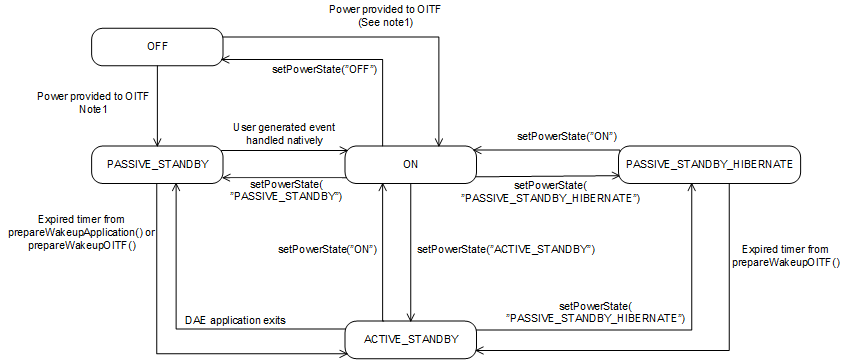
NOTE 1: The transition from the OFF state to the PASSIVE_STANDBY or ON states is manufacturer dependent
Display Model
Annex describes the logical display model of an OITF and the relationship between DAE application graphics and video.
